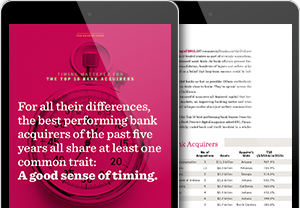
The Top 10 Bank Acquirers
Since the beginning of 2010, 567 commercial banks and thrifts have been purchased by publicly traded lenders as part of strategic acquisition, merger-of-equals or distressed asset deals. As bank officials pressed forward in this period of consolidation, hundreds of buyers and sellers alike chose to cut deals based on a belief that long-term success could be bolstered by M&A.
Some gobbled up failed banks as fast as possible. Others methodically looked for a few add-on deals close to home. They’re spread across the country, from Florida to California.
However, the most successful acquirers all deployed capital that leveraged resurgent stock markets, an improving banking sector and wise deal-making that resulted in larger market share just as their communities sprang back to life.
In search of a list of the Top 10 best performing bank buyers from the perspective of investors, Bank Director digital magazine asked SNL Financial to analyze every publicly traded bank and thrift involved in a whole-bank acquisition since Jan. 1, 2010. The research service ranked each acquirer by total shareholder return over that period, providing an objective picture of how much value had been created for investors over time. The total return calculation reflects the percentage change of the company’s stock price from Dec. 31, 2009 at the basis of 100 to June 16, 2015 with cash dividends reinvested. Bank Director digital magazine then compiled a list of the acquirers buying more than one other bank over the time period (119 total), to highlight the M&A-minded banks that created the most value for shareholders during this era of consolidation. A clear trend emerged: Small and midsize banks with depressed stock prices in 2010, but a balance sheet strong enough to support growth and acquisitions, delivered the strongest returns for investors.
“It’s hard to judge based on a single point in time, but, ultimately, total shareholder return is what matters most to investors,” Sandler O’Neill + Partners banking analyst Brad Milsaps says. “These banks clearly benefitted from a recovering market.”
At the top of the list, Phoenix-based Western Alliance Bancorporation notched a total shareholder return of 907.4 percent. It outperformed all others as it benefitted from a strengthening Southwest geography and remarkable asset growth that fueled profits and a stock price that improved 582 percent.
“We’re in rebounding markets,” Western Alliance Chief Financial Officer Dale Gibbons says in an interview. “The Southwest was hit hard, and it is coming back strong.”
Western Alliance shares (NYSE:WAL) closed at $5.13 on Jan. 1, 2010 and improved to prices near $35 per share when the rankings were completed this June. Add dividends to the equation and it’s easy to see how the company scored such high returns.
Milsaps, who covers Western Alliance, says the lender is just now returning to share prices it experienced before the recession, but its post-recession recovery has been among the best.
“As one of the only banks of its kind in that region to survive, so to speak, it has been able to attract a lot of customers from other banks,” he says.
Western Alliance has also acquired three banks since 2010, all strategic add-ons to expand its territory in Arizona, Nevada and California. The deals included the 2015 purchase of San Jose, California-based Bridge Capital Holdings, the 2013 acquisition of Fountain Valley, California-based Centennial Bank and the 2012 purchase of Western Liberty Bancorp in Las Vegas.
Western Alliance in 2010 prepared for its expansion by issuing 7 million new shares and raising $75 million in debt offerings. Gibbons says focusing on strengthening the company’s balance sheet and executing an organic growth strategy helped it grow to $11.3 billion in total assets from $5.8 billion in assets. About 80 percent of that growth can be attributed to organic expansion.
He says the bank also made strategic decisions after the recession to focus on commercial banking and specialized lines of commercial lending, leaving residential mortgages behind.
“We decided not to be all things to all people,” Gibbons says. “You must have a strong core bank to allow you to be successful in acquisitions. You can’t be bogged down with distractions.”
Across the country in Greensboro, North Carolina, NewBridge Bancorp made the top 10 with 383.8 percent total shareholder return. NewBridge made three acquisitions over the period, growing from $1.9 billion in total assets to $2.7 billion. The deals included the 2013 purchases of Security Savings Bank and CapStone Bank, and the 2014 purchase of Premier Commercial Bank, all three in North Carolina.
Chief Banking Officer Spence Broadhurst says NewBridge’s board of directors and management team added an extra set of criteria to its M&A process. In addition to the traditional numeric evaluations, Broadhurst says NewBridge looked to buy banks that lacked products and services NewBridge offered.
For example, NewBridge offers its community bank customers commercial real estate loans up to $25 million, a much larger lending cap than many peers. The bank also offers more trust and estate planning services, wealth management and private banking than its rivals, Broadhurst says.
“Understanding the economics of transplanting organic growth into the banks you acquire is the key,” he says. “We think our strategy has shown the real value is found looking beyond traditional metrics. That has added shareholder value and shortened the payoff time.”
Two other lenders on the top 10 list used much different tactics. Both Arkansas-based Bank of the Ozarks Inc. (703.9 percent TSR) and Georgia’s Ameris Bancorp (372.6 percent TSR) grew and created shareholder value in part by leveraging distressed asset purchases.
Bank of the Ozarks has purchased 12 whole banks since 2010, including seven failed bank deals with the FDIC. Ameris acquired 11 lenders over the past five years, and eight of them involved loss-share agreements with the FDIC.
Such strategies are paying off now because banks strong enough to buy failed assets gained scale early in the consolidation wave, then pivoted to buy larger and often healthier partners in strategic locations more recently.
Good timing proved to be important for sellers, too.
Mark Saunders, managing director and head of research at Atlanta-based investment bank Banks Street Partners, says sellers that paired with growth-minded buyers several years ago have seen the biggest payoff, even if their sale price was depressed at the time.
“The clear vision of hindsight tells us now that getting into the ground floor with those companies in 2010 to 2012 could yield significant upside for a seller that was willing to look past the immediate premium shareholders would receive,” he says.
Ranking by total shareholder return leaves plenty of room for debate. Some analysts prefer to judge M&A by earnings accretion following a deal. But those metrics become muddy if a bank strikes multiple deals in a short time period. Others prefer to evaluate M&A based on stock price appreciation between the time the deal was announced and when it closed. But that method doesn’t account for the success of the merger over time.
“It’s just not easy,” says Mark Fitzgibbon, director of research at Sandler O’Neill + Partners. “Prices can move up or down on unrelated events. It can be hard to isolate the impact of a single deal.”
Still, evaluating total shareholder return over a long horizon provides a clear picture of which acquirers are producing long-term results for their stockholders. “We think M&A can be a strong complement to our shareholder growth,” says Gibbons, the CFO at Western Alliance. “It’s a very interesting topic for our board.”

Join OUr Community
Bank Director’s annual Bank Services Membership Program combines Bank Director’s extensive online library of director training materials, conferences, our quarterly publication, and access to FinXTech Connect.
Become a Member
Our commitment to those leaders who believe a strong board makes a strong bank never wavers.


